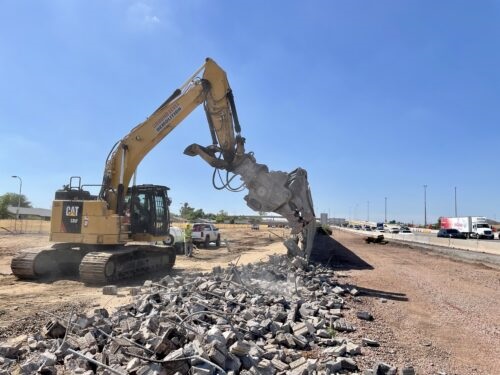The Arizona Department of Transportation recently outlined how it reuses a variety of highway construction materials – such as asphalt, concrete, and steel – to reduce overall transportation project costs and preserve the environment.
[Above photo by the Arizona DOT]
“We reuse as much as we can so nothing goes to waste,” explained Kole Dea, senior resident engineer with the Arizona DOT, in a blog post. “If something can’t go back into the project, then it’s recycled.”
Dea used the I-10 Broadway Curve Improvement Project to highlight how the agency reuses and recycles highway construction materials – both as part of the same project as well as externally on different projects.
For example, when construction began on the I-10 Broadway Curve project in summer 2021, crews removed the rubberized asphalt from the surfaces of I-10 and US 60 in the project area. That work created 1.3 million square yards of asphalt millings, which then formed the base layer for temporary haul roads in the project area. Millings provide a strong base for trucks and equipment to drive on, and they reduce dust – another plus for the environment. Furthermore, the agency mixed those millings with dirt to build embankments to provide additional support to those temporary roadways. Outside of the project area, Arizona DOT said it uses millings on maintenance roads in unpaved areas.
As the agency removes walls and other concrete structures to make way for new construction, they are broken up to serve a new purpose. Arizona DOT said its crews use equipment to break each piece into sizes no larger than 24 inches. Those pieces then become fill material for building up approaches for new bridges. They also fill in holes or otherwise supplement unstable materials in the project area.
The agency also removes steel rebar and other metal materials and takes them to a recycling facility – pointing out that recycled steel is as strong and durable as new steel made from iron ore.
Arizona DOT stressed that it works in compliance with state and federal regulations to ensure all reused materials do not threaten the environment. For example, the agency tests the paint stripes on milled asphalt to ensure it does not contain lead, and that old pipes or bridge structures are free from asbestos.
Several state departments of transportation have reused materials left over from highway and other transportation infrastructure projects for a variety of purposes – especially environmentally focused ones.
For example, in 2021, the Maryland Department of Transportation began oversight of contracts with two Maryland companies to make bricks, pavers, concrete highway barriers, and shoreline supports – among other structures – from dredged material cleared from a shipping channel within the Port of Baltimore.
In addition, in early 2022, the North Carolina Department of Transportation provided more than 1,000 tons of damaged concrete pipe to help the North Carolina Division of Marine Fisheries shore up two artificial reefs.

